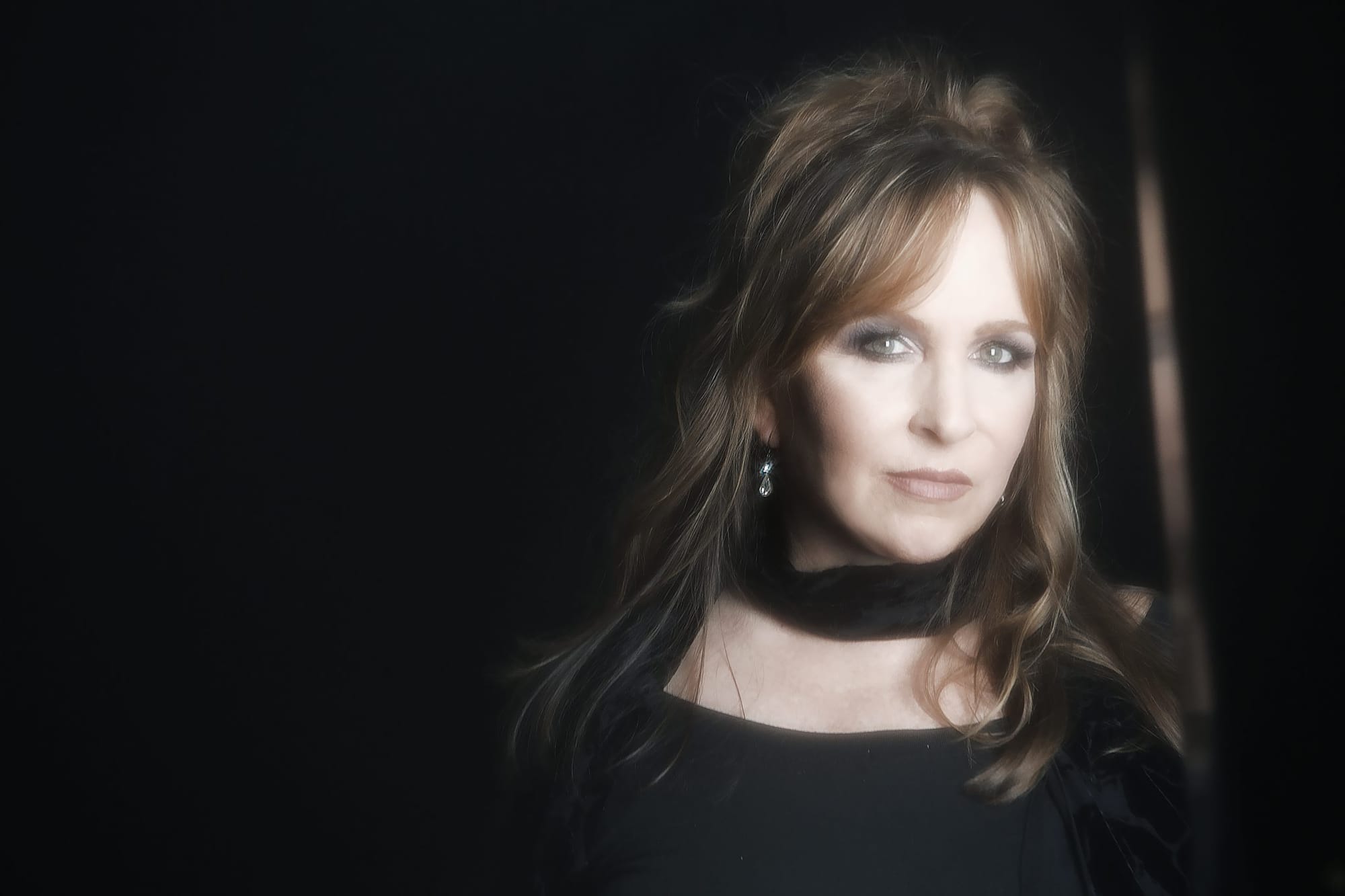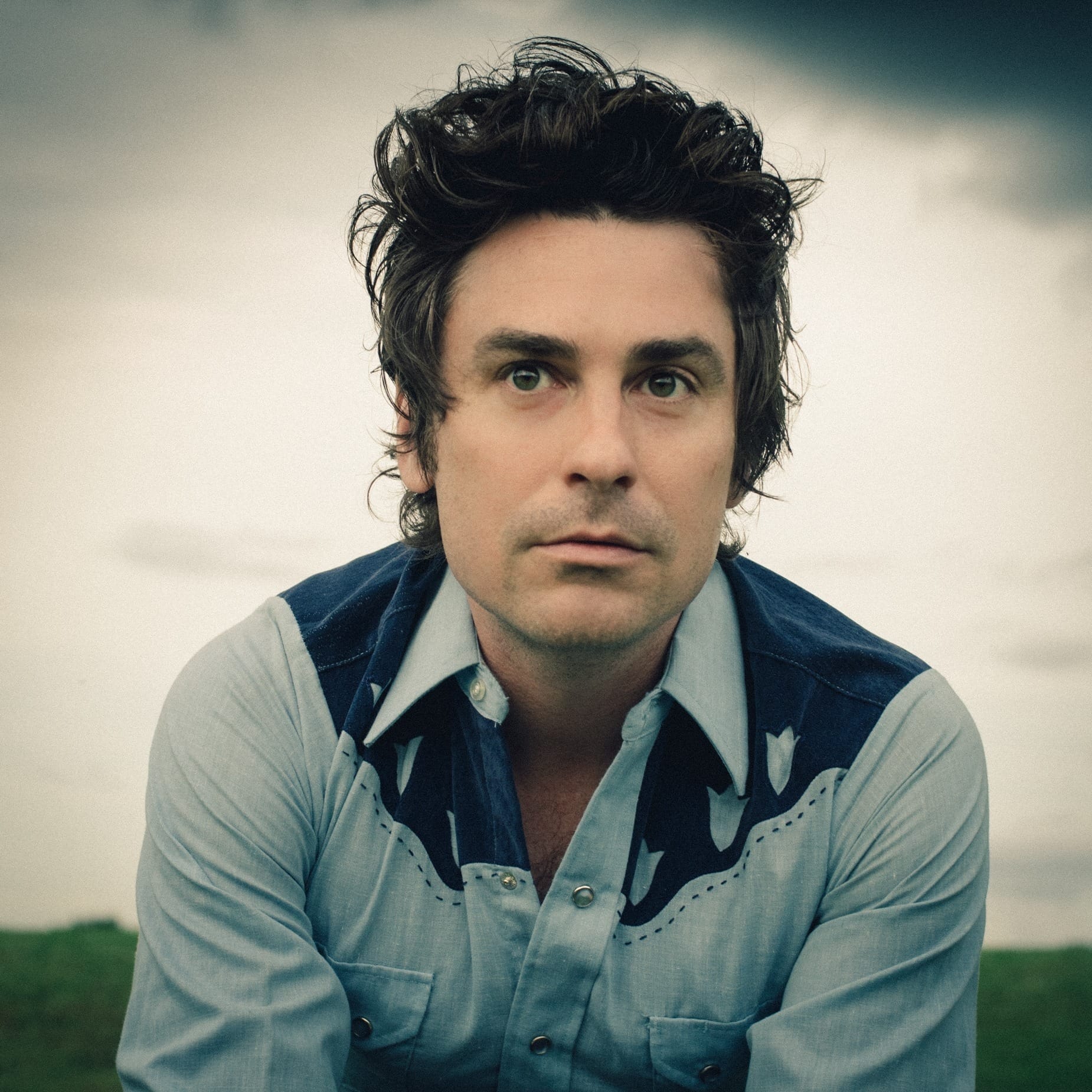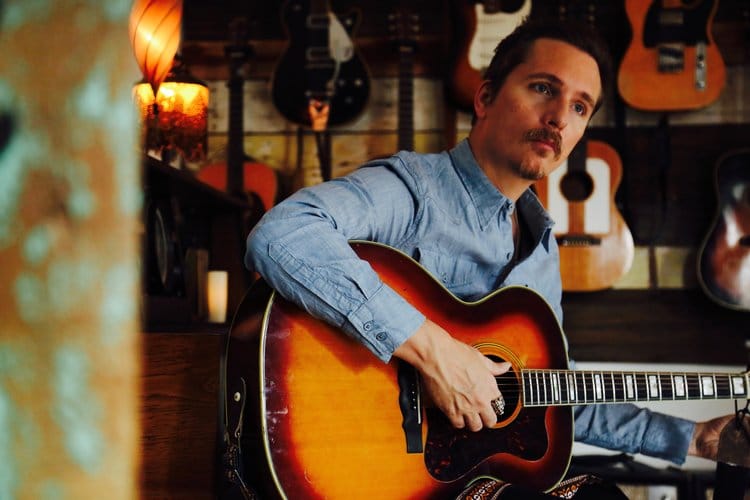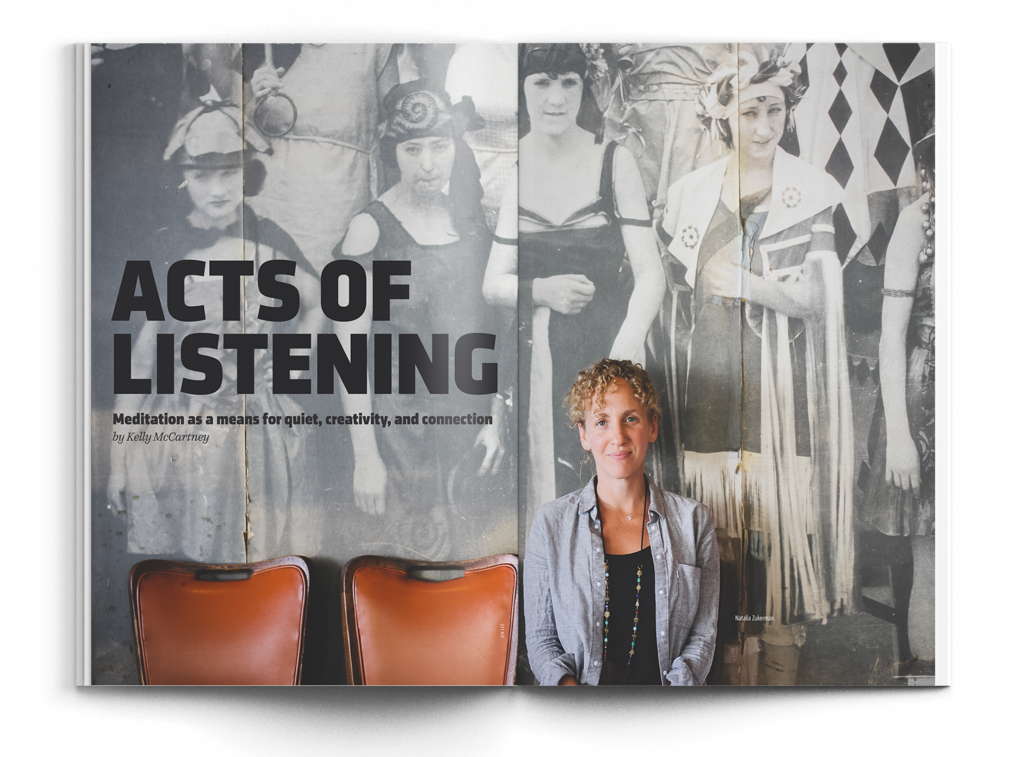As part of the story “Acts of Listening” in No Depression's Wellness-themed Fall 2019 print issue, we asked several roots artists to share with us their meditation practices and how mindfulness helps them stay healthy and creative. Our writeup of their responses is below. Our full story, including insights from Molly Tuttle, Natalia Zukerman, Peter Bradley Adams, and Ben Glover, is available here.
Angaleena Presley
Meditating For: 12 years
Practice: Breath work for 20 minutes whenever it fits into a day
Recommended Resources: Yoga classes and books — The Bhagavad Gita, The Prophet, The Alchemist, The Power of Now, A New Earth: Awakening Your Life’s Purpose, The Seat of the Soul, and Eat, Pray, Love
Attending a yoga class after her son's birth opened up a whole new world for singer-songwriter and Pistol Annie Angaleena Presley that led her to slip meditation into her chaotic life. It wasn't easy to get it going, though.
“I spent a lot of time shaming myself for not being able to consistently uphold a practice, but then I realized that was defeating the purpose,” Presley says. “I gave myself permission to build my practice around my life and not vice versa.” Sometimes that means taking time in the bathroom before she goes on stage; other times, it means meditating while breastfeeding her daughter or trying to fall asleep.
Because she doesn't subscribe to any particular religious or spiritual path other than “kindness, acceptance, love, vulnerability, and faith in something bigger than me,” Presley found focusing on her breath to be her most natural practice. “When I was a kid, I would notice my breath, and it would give me anxiety because, even at a young age, I could sense how precious and fragile it was,” she confesses. “I understood the magnitude of it. I guess I still do; only now, it’s a comfort to check in and honor it rather than fear the absence of it.” The breath work leaves her more grounded in, more focused on, more patient with, and more connected to both her life and her work. It also helps keep her ADHD and tidiness in check.
“I’m a terrible housekeeper, but when I get going on a good run of daily meditation, I organize. It’s like my mind starts to clear and my body goes on auto-pilot and begins creating an environment that reflects what’s going on in my head,” she offers. “If you want to know how my practice is going, come visit me. If I have to rinse a glass to give you a drink of water, you’ll know it’s been a long time since I took a minute to catch my breath.”
“I look at meditation as a way to check in with the source, a way to let the universe know that I’m grateful for and open to whatever is supposed to happen next,” Presley says. “If it’s a song, wonderful. If it’s the death of a beloved pet, fine. It’s all about learning and growing and being present in the experiences I have, no matter the nature of them.”
Gretchen Peters
Meditating For: 3 years
Practice: Guided meditation for 10 minutes first thing in the morning
Recommended Resources: Meditation apps like Meditation Oasis and Calm

A few years back, when Gretchen Peters' self-managed career as an independent artist took a turn for the better, she found herself working 12-14 hours a day with no parameters or structure. The stress of saying “yes” to any and every opportunity started taking its toll.
“I found myself unable to shut down from work mode. My health suffered, I felt scattered, and I was afraid I was approaching burnout,” she confides. “I thought meditation might help me create some boundaries around my own personal time and help me cope with the stress.”
Peters drew her own boundaries, setting aside about 10 minutes in the morning, just after waking up, to be in a meditative space, guided by an app (Meditation Oasis is her favorite). She also loves to meditate on planes, while the outside world is already shut out for a little while. Stepping into meditation and out of the chaos lowers her stress levels and increases her creative connections. “In workshops, I tell my songwriting students that they can’t create and consume at the same time. And, in 2019, we're all consuming constantly — there's an avalanche of information coming at us 24/7,” Peters explains. “Meditation quiets that down, stops the monkey brain, asks you to be still. All things that are incredibly helpful with creative endeavors.”
Her practice has helped her learn to pause rather than react in any given situation, whether personal or professional. “Meditation is a tool that helps me cope with all the unpredictability and drama that comes with what I do,” she says.
While not a religious person, Peters believes deeply in kindness and compassion. Meditation has taught her to apply those values to herself in her own life and practice. “If I worship at any church, it’s the church of empathy. Empathy requires that you suspend judgment, and it seems to me that meditation is exactly that — the suspension of judgment,” Peters offers. “You will have random thoughts, and the aim is not to not have those thoughts, but to let them pass without judgment. If you can learn to do that for yourself, I don’t see how you can't not do it when it comes to other people. In that way, I think it’s heart-opening.
Eliot Bronson
Meditating For: 12 years
Practice: Sitting in awareness of all the senses for 30 to 60 minutes each day
Recommended Resources: Headspace and 10% Happier apps, The Joy of Living by Mingyur Rinpoche, and unfetteredmind.org

It was a teen-era reading of The Tibetan Book of Living and Dying by Sogyal Rinpoche that first got Eliot Bronson interested in Buddhism and affirmed beliefs he held but couldn't verbalize. From there, he dove headlong into Eastern philosophy, meditation, and yoga, attending a retreat with Zen master Thich Nhat Hanh when he was 19. But it took some years before he had anything resembling a regular practice. “[Thich Nhat Hanh's] approach was so simple and yet full of heart. It was a great entry point,” he says. “Something about the Tibetan schools kept calling me, though, so that's probably where I've spent the most time and effort.” Studying with Tibetan Buddhism teacher Ken McLeod also opened the practice up for him.
Bronson grew up in a Fundamentalist Christian church where faith was taken blindly. These new teachings offered a different way. “Meditation and the Buddhist philosophy that accompanied it spoke to something deep in me that nothing else was quite able to,” he says. “It also offered a spiritual technology that I could use. It was something I could 'do,' which is a little ironic, because meditation is more of an 'undoing' than anything else. The longer I meditate, the more beliefs I realize I have to let go of. Beliefs, no matter how beautiful or empowering, are still thoughts, still a map that we place over the world. Reality is something we experience directly, before we add the names and definitions.”
Over the years, Bronson has explored a number of Buddhist paths, including vipassana, dzogchen, and shikantaza. His current daily practice doesn't strictly adhere to any one style, though it comes closest to shikantaza. “Essentially, it is sitting in wide open awareness of all the senses, thoughts, and emotions, then looking right at awareness itself,” Bronson explains. No matter which way he leans on any given day, he says, “I just try not to get caught in doing it 'right.' I follow my intuition.”
For Bronson, meditation is a clearing out, a making space. He doesn't use it as a productivity tool or a creativity connector, though those are helpful byproducts. “I think it's more like house cleaning, sometimes. It's hard to cook in a dirty kitchen,” he explains. “When I'm sitting regularly, I'm less neurotic. There's more space. And I certainly need space to be creative. If I miss a day, I can really feel it. I'm not centered. I catch myself in mental loops and I'm more addicted to my phone.”
Emily Scott Robinson
Meditating For: 10 years
Practice: Daily check-ins, plus focused, intentional visualization for about 25 minutes a week
Recommended Resources: The Illumination Process by Alberto Villoldo, The Power Path by José and Lena Stevens, The Four Agreements by Don Miguel Ruiz

“Tumult and confusion” were Emily Scott Robinson's catalysts for change in her early 20s. She was processing a tough trauma, a rough breakup, a promising relationship, and a new job all at the same time, and she felt that she needed a helping hand. A teacher named Christopher Beaver introduced her to shamanic meditation and ritual practice, and she's been a devotee ever since, adding healer Dawn Eagle Woman to her studies more recently.
The results? “I sleep well at night, I do work that matters and has a bigger purpose in the world, and I love my life,” she says. “I am a really positive person, and I feel deeply connected to the flow of the universe. I'm always growing and changing and life feels like an adventure. I know my purpose, and I'm living my dreams.”
Robinson's meditation practice, which is her spiritual path, involves taking at least a few minutes every day to check in with her breath, body, and deepest wisdom. She follows that up with a daily ritual of setting intentions and journaling. At least once a week, she spends about 25 minutes going inward with a focused, intentional visualization practice. “Every meditation is like a journey into my own consciousness and deeper wisdom,” Robinson explains. “I get grounded with both earth and celestial energies. I call in my animal guides and protective spirits. I purify my intentions, and then I explore a question or issue I am experiencing at that moment. I often use an oracle [card] deck to help guide my practice.”
Checking in with her higher self and deepest wisdom on a daily basis gives Robinson a sense of clarity and focus about what she does and doesn't want in her life. “I hold every decision — big and small — up to my soul's purpose and see if they're in alignment,” she says. “It is not easy work, especially doing it every day. It's often an assault on my ego.” But it gives her the strength of purpose to move through this world unattached to others' assaults on her ego, which is awfully helpful for a musician.
Anthony D'Amato
Meditating For: 5 years
Practice: Breath work for 5 to 20 minutes whenever necessary
Recommended Resources: Coherent Breathing recordings, Headspace app
Unlike most people, who come to meditation for spiritual reasons, Anthony D'Amato arrived for purely psychological pursuits after a doctor suggested he try the Coherent Breathing exercises as a way of dealing with his anxiety. “At first, I didn’t even realize that what I was doing was meditating because I don’t come from a place where that’s a really common thing, or at least it’s not something people talk about,” he confesses. “Coherent Breathing really clicked with me because it was so subtle that I could do it without anyone noticing. I’d put my headphones in and listen to the bells, and everyone else just thought I was listening to music or a podcast or something. When you’re dealing with panic or anxiety, the last thing you feel like you want to do is announce it to everyone around you.”
Unless he's in the driver's seat, D'Amato's panic attacks spin up whenever he climbs into the tour van. The breathing exercises calm the attacks, but they also help him wind down after a show so that he can relax enough to fall asleep. “The particular recording I latched onto is a series of bells that signal when you inhale and when you exhale, and they’re timed to create a rhythm that slows your heart rate down and settles your spikes in anxiety,” D'Amato explains.
At home, his anxiety is more controlled and controllable, D’Amato says, though he recently started a daily practice with the Headspace app.
“I always thought meditation was something for other people who are more normal and calm and collected than I am, so I never really bothered trying,” he says. Now, though, he's excited to see what more will come of his efforts. “I suspect that the reasons I need to meditate — an overactive, emotionally sensitive mind with a tendency to fixate — are the same reasons I’m a songwriter,” D'Amato offers. “Meditating and songwriting are both ways of exorcising the gremlins a little bit.”
Shane Alexander
Meditating For: 20 years
Practice: Morning and evening mantra chanting, sutra recitation, and silent prayers as part of Nichiren Buddhism
Recommended Resources: The Writings of Nichiren Daishonin 1 & 2

A couple of decades ago, while he was working at a record label in Los Angeles, singer-songwriter Shane Alexander was a seeker in search of path when a co-worker introduced him to Buddhism, specifically the style as taught by 13th-century Buddhist scholar Nichiren Daishonin.
Alexander's daily practice entails morning and evening sessions of chanting and prayer for anywhere from five minutes to an hour. “Because it’s a daily discipline, it starts and ends the day on the right foot — helping to forgive and get back to focusing on happiness for myself and others,” he says. “The purpose of the practice is to become unshakably happy and in rhythm with our environment. I find that, the stronger my practice is, the more good fortune — creativity included.”
For Alexander, the benefits of meditation include presence and gratitude gleaned from the willingness to set aside the time to practice, even when on the road. “I think it helps me to maintain a feeling of gratitude through any low times I might face, especially on the road where it’s easy to get into a negative headspace,” he explains. “Also, I find that by being in rhythm, I often find myself right where I need to be.”
Having been raised in a Christian family, Alexander has had to sort out the disparities between the teachings of his early life and adulthood. But he's found a way: “My Christian upbringing and my Buddhist faith are seemingly at odds with each other, but I once asked a Buddhist elder about it and he said, 'Chant to be a better Christian.'”
For more on how roots musicians found and use meditation in their creative and personal lives, see the story “Acts of Listening” in our Fall 2019 print issue, available here. Please consider subscribing to No Depression to support roots-focused music journalism all year long.






Comments ()